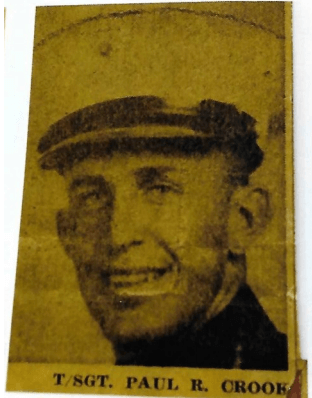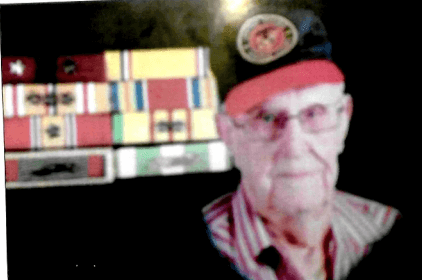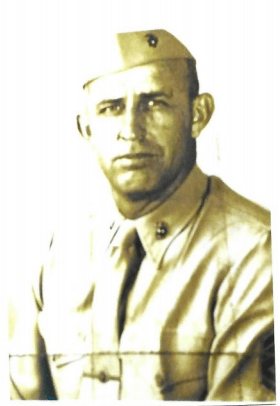Master Gunnery Sergeant Paul Crook
My Afternoon with a WWII Hero
By Tammy Watson, Navigator
I will never forget June 4, 2017. After completing what seemed like an endless, 12- hour shift in the ICU at Florida Hospital in Zephyrhills, I entered the elevator that routinely takes me down three floors to the lobby at the end of each day. This afternoon would prove to be anything but routine.
I shared an elevator ride with a gentleman whose ball cap read WWII/ Korea Veteran. I thanked him for his service and inquired which theaters he served in. I discovered that he had seen many places, as a United States Marine who served our country over 27 years.
In those brief moments of that elevator ride, I realized before me was a man of historical greatness. Realizing there was far too much history to simply let this man disappear and more information than I could gather in a three-minute elevator ride, I took a chance and asked Mr. Crook if he would be willing to sit down for an interview about his service. After a bit of humble protest, he relented and said yes. It turned out to be the interview of a lifetime.
Master Gunnery Sergeant Paul Crook was part of the Marine Air Group VMF-221. I asked what made him want to join the Military? Those eyes that saw much combat, leading many times to tears of great sadness, on this day many years later, twinkled at the question. As a broad smile along with what appeared to be a tinge of embarrassment, made their way across his seasoned face, I braced myself for the answer. I surmised his answer would have something to do with a valiant statement about his love for patriotism that would cause me to mentally hear that famous stanza recalling “the bombs bursting in air” and visions of the waging “perilous fight” as the song played in the recesses of my mind.
As fate would have it, Mr. Crook was an avid outdoors person like myself and our shared love for fishing and hunting would lead to the unfolding of a humorous story that proved to be the catalyst to his 27-year career.
Paul Crook was sixteen years old in North Carolina when he got into trouble and placed on probation for hunting (otherwise known as poaching by game wardens) at the Biltmore Estate! Yes, THAT Biltmore Estate. That event, combined with his “not liking school much” made him realize that he was headed down the wrong road. He decided that the best way to change his life for the better was to join the Marines. Mr. Crook discovered that the Marines wouldn’t take him as long he was on probation. It was explained to him that the judge presiding over his case would have to rescind the probation in order for him to enlist. One would think that simply speaking to the judge back then was easy enough, especially given a young man’s newfound desire to serve his country.
The judge did agree to wave probation, however, not without a strong warning, “I will let you off probation if you promise you will join the service, but if I let you off probation and you do not join you will be splitting rocks, doing hard labor at Craggy Pinnacle!” The splitting of Craggy Pinnacle’s rocks in Ashville North Carolina has long since ceased, and thankfully, Mr. Crook had no part of that, as he took the judge’s words very seriously. With that, the teenager left the world of hunting, fishing and working in the family dry cleaning business he had become accustomed to. He left it all behind to take on the sometimes humorous, but mostly hard days of basic training at Paris Island in 1940.
 His first assignment took him to Pearl Harbor in 1942, where he boarded the U.S.S. Saratoga bound for Wake Island. While in route the fleet was informed Wake Island was taken by the Japanese and the Saratoga was being redirected to Midway, stationing the squadrons on Eastern Island. Once set up, PFC Crook’s duty was to refuel the squadron’s F2A Brewster Buffalo Fighters. The Battle of Midway would conclude with a 62 percent casualty rate for his squadron, and earned him a letter of commendation for conspicuous courage and heroic service from Frank Knox, Secretary of the Navy under Franklin D. Roosevelt. His last tour of duty, began in 1966 when he voluntarily came out of retirement to serve not one, but two tours in Vietnam with the First Marine — Aircraft Wing, under President Lyndon Johnson.
His first assignment took him to Pearl Harbor in 1942, where he boarded the U.S.S. Saratoga bound for Wake Island. While in route the fleet was informed Wake Island was taken by the Japanese and the Saratoga was being redirected to Midway, stationing the squadrons on Eastern Island. Once set up, PFC Crook’s duty was to refuel the squadron’s F2A Brewster Buffalo Fighters. The Battle of Midway would conclude with a 62 percent casualty rate for his squadron, and earned him a letter of commendation for conspicuous courage and heroic service from Frank Knox, Secretary of the Navy under Franklin D. Roosevelt. His last tour of duty, began in 1966 when he voluntarily came out of retirement to serve not one, but two tours in Vietnam with the First Marine — Aircraft Wing, under President Lyndon Johnson.
Along with his accounts of battles, fought alongside his many brothers, some still living but many who have since passed on, this witty Marine had his share of funny, personal stories as well. Like his account in 1945, while still stateside, of Bob Keeshan who was briefly his bunkmate, long before he was Captain Kangaroo, and going on liberty with Shirley Temple’s brother. (Sorry, those details remain a mystery!)
 One afternoon in Vietnam (1966), he looked up from his desk to see John Wayne, who made his way into the tac office to have a conversation with him. Before Wayne was gruffly ordered back to the set by the director of his latest film, he was heard saying, in that infamous drawl, “I don’t want to talk to actors and people who just know highlights, I want to talk to real Marines that have done it!”
One afternoon in Vietnam (1966), he looked up from his desk to see John Wayne, who made his way into the tac office to have a conversation with him. Before Wayne was gruffly ordered back to the set by the director of his latest film, he was heard saying, in that infamous drawl, “I don’t want to talk to actors and people who just know highlights, I want to talk to real Marines that have done it!”
One of my favorite stories was from 1943. On a quiet afternoon, while serving as Squadron Chief of the F4U, Corsair Fighting Training Unit, at El Toro California, Mr. Crook was summoned his Commander’s office to be briefed and introduced to Colonel Charles Lindbergh. Mr. Crook was told that he would be readying planes for Colonel Lindbergh who was investigating the deaths of eight pilots killed in the F4U, Corsair planes, also known as Whistling Death. The pilots in charge of test flights would perform maneuvers that required them to take the aircraft up into a loop.
When they cut the engine at the top of the loop the plane would fall from the sky. One afternoon Mr. Crook approached the Corsair that Lindbergh had just landed to help him from the plane. As he loosened the harness he noticed that Lindbergh seemed confused and pale. After asking twice if he was okay, Colonel Lindbergh assured Mr. Crook that he was, in fact, feeling very okay, as he had discovered the reason the pilots had crashed the Corsair. He explained the Corsair had unparalleled power and performance due to the inverted gull wing that reduced drag and weight. Combined with the aircraft’s center of lift that lowers relative to the center of gravity, the Corsair had the ability to simply pull through the loop, re-stabilize and continue in flight, provided the pilots did not cut the engine while taking the aircraft up into the loop. Colonel Lindbergh’s discovery during the test flight that day prevented any further pilot deaths as the result of this type of maneuver.
Several years passed after that encounter with Lindbergh, and Mr. Crook wanted to visit his gravesite. During a trip to Hawaii he and his wife, Vi, were unable to locate the secret grave site. After encountering a park ranger, they were directed to Palapala Ho’omau Church on the island Hana Maui. No longer a secret, today the gravesite is one of the most visited sights by tourists. However, on that day in the quiet sanctuary of those beautiful gardens, Mr. Crook and his wife cherished a few moments of privacy at the grave of the man that greatly impacted his life.
 Before arriving at the Crook’s home that afternoon I told my husband we would probably be finished with the interview and back on the road within 45 minutes to an hour. The time flew by and after three hours we said our goodbyes. Mr. Crook and his wife walked us to the door and told us that we are were always welcome to visit. As I hugged him goodbye one thing remained very apparent to me. Somewhere inside this great man, that incidentally, shares the same birth month and day as my daughter, and whom we all remain forever indebted to, still resides the sharpness and quick wit of a sixteen-year-old young man who relished secret hunts on the grounds of the Biltmore Estate so many years ago.
Before arriving at the Crook’s home that afternoon I told my husband we would probably be finished with the interview and back on the road within 45 minutes to an hour. The time flew by and after three hours we said our goodbyes. Mr. Crook and his wife walked us to the door and told us that we are were always welcome to visit. As I hugged him goodbye one thing remained very apparent to me. Somewhere inside this great man, that incidentally, shares the same birth month and day as my daughter, and whom we all remain forever indebted to, still resides the sharpness and quick wit of a sixteen-year-old young man who relished secret hunts on the grounds of the Biltmore Estate so many years ago.











